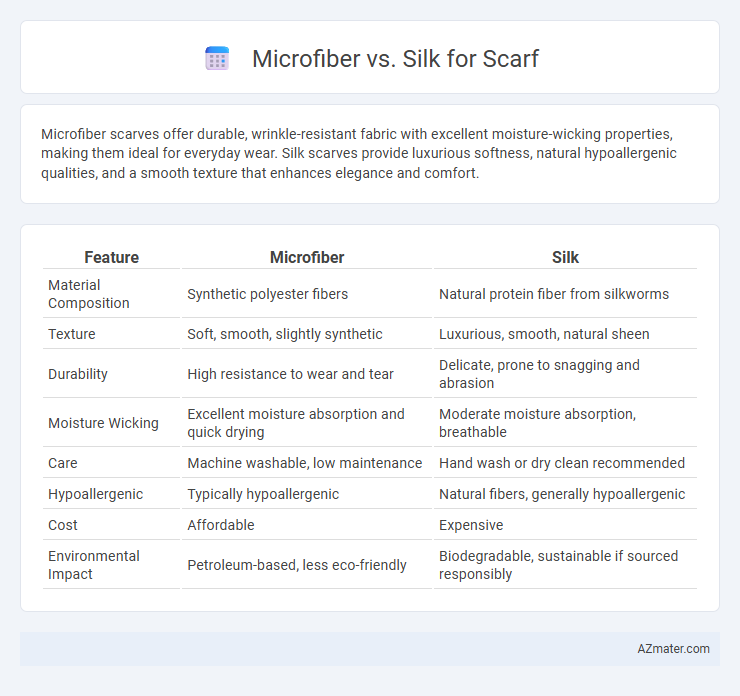Microfiber scarves offer durable, wrinkle-resistant fabric with excellent moisture-wicking properties, making them ideal for everyday wear. Silk scarves provide luxurious softness, natural hypoallergenic qualities, and a smooth texture that enhances elegance and comfort.
Table of Comparison
| Feature | Microfiber | Silk |
|---|---|---|
| Material Composition | Synthetic polyester fibers | Natural protein fiber from silkworms |
| Texture | Soft, smooth, slightly synthetic | Luxurious, smooth, natural sheen |
| Durability | High resistance to wear and tear | Delicate, prone to snagging and abrasion |
| Moisture Wicking | Excellent moisture absorption and quick drying | Moderate moisture absorption, breathable |
| Care | Machine washable, low maintenance | Hand wash or dry clean recommended |
| Hypoallergenic | Typically hypoallergenic | Natural fibers, generally hypoallergenic |
| Cost | Affordable | Expensive |
| Environmental Impact | Petroleum-based, less eco-friendly | Biodegradable, sustainable if sourced responsibly |
Introduction: Microfiber vs Silk Scarves
Microfiber scarves offer lightweight durability with excellent moisture-wicking properties, making them suitable for everyday wear and easy maintenance. Silk scarves provide a luxurious, smooth texture with natural temperature regulation and vibrant color retention, ideal for sophisticated fashion statements. Both materials deliver unique benefits tailored to different style preferences and functional needs.
Key Material Differences
Microfiber scarves are made from finely woven synthetic fibers, offering high durability, moisture-wicking properties, and resistance to wrinkles and stains. Silk scarves consist of natural protein fibers produced by silkworms, prized for their luxurious softness, breathability, and smooth texture that regulates temperature effectively. Unlike microfiber, silk is more delicate and requires gentle care, while microfiber provides a cost-effective, easy-to-maintain alternative with a similar sleek appearance.
Comfort and Softness Comparison
Microfiber scarves offer exceptional softness due to their fine synthetic fibers, providing a smooth and lightweight feel that resists wrinkles and dries quickly. Silk scarves, made from natural protein fibers, are renowned for their luxurious softness and breathability, adapting comfortably to skin temperature. Comparing comfort, silk's natural hypoallergenic properties make it ideal for sensitive skin, whereas microfiber provides durable softness with easier maintenance.
Breathability and Temperature Regulation
Microfiber scarves offer excellent breathability due to their fine synthetic fibers that wick moisture away, making them ideal for maintaining a cool and dry feel in warmer weather. Silk scarves naturally regulate temperature by providing lightweight insulation that traps warmth in cooler conditions while allowing air circulation to prevent overheating. Both fabrics excel in comfort, but silk's natural protein structure enhances temperature regulation, whereas microfiber's engineered fibers prioritize moisture management and quick drying.
Durability and Longevity
Microfiber scarves exhibit high durability due to their synthetic fibers that resist wear, tear, and fading, making them ideal for everyday use. Silk scarves, while luxurious and soft, require delicate care as natural fibers are prone to snags and reduced lifespan when exposed to frequent handling or harsh washing. Choosing microfiber over silk ensures longer-lasting vibrancy and structural integrity in scarves subjected to regular wear.
Care and Maintenance Requirements
Microfiber scarves require easy care with machine washability, quick drying, and resistance to wrinkles, making them ideal for frequent use and low-maintenance routines. Silk scarves demand delicate hand washing or dry cleaning to preserve their natural fibers, with careful handling to avoid damage from water, heat, or abrasive detergents. Proper storage for silk includes avoiding prolonged sunlight exposure and folding to prevent creases, while microfiber is more durable and less sensitive to storage conditions.
Hypoallergenic Properties
Microfiber scarves are renowned for their hypoallergenic properties, as the synthetic fibers resist dust mites, allergens, and bacteria buildup, making them suitable for sensitive skin. Silk scarves also offer hypoallergenic benefits due to natural protein fibers that repel common allergens and prevent irritation. Choosing between microfiber and silk depends on personal comfort preferences and sensitivity, with both materials providing effective allergy-friendly options.
Sustainability and Environmental Impact
Microfiber scarves, made from synthetic fibers like polyester, contribute to microplastic pollution due to their non-biodegradable nature and high energy consumption during production. Silk scarves are produced from natural protein fibers, making them biodegradable and renewable, though silk farming requires significant water and resource inputs. Overall, silk offers a more sustainable option if sourced ethically, while microfiber's environmental impact is higher due to synthetic waste and resource intensity.
Price and Value Considerations
Microfiber scarves typically offer an affordable price point, making them accessible for budget-conscious buyers, while silk scarves command higher prices due to their natural fibers and luxurious feel. Despite the higher cost, silk scarves provide superior breathability, softness, and durability, resulting in long-term value and comfort. Microfiber, being synthetic, often requires less care and resists stains, offering practical value for everyday wear without the premium investment of silk.
Choosing the Right Scarf for You
Microfiber scarves offer durability and moisture-wicking properties ideal for active lifestyles, while silk scarves provide a luxurious feel and natural breathability perfect for formal occasions. Consider factors such as skin sensitivity, style preference, and maintenance requirements when choosing between microfiber and silk. Selecting the right scarf involves balancing comfort, appearance, and care to match your daily needs and wardrobe.

Infographic: Microfiber vs Silk for Scarf
 azmater.com
azmater.com